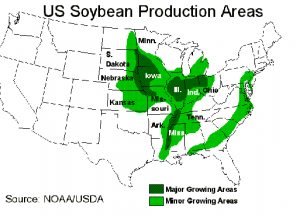This is my first trade and I started my trade with soybeans.
First of all, I wanted to know more about soybean itself and as a commodity:
- What are they used for [1]?
- Direct human consumption, processed into other foods for human consumption
- Processed into animal feed
- Used to produce biodiesel fuel
- Used in the production of industrial products like oils, plastics, etc
- Who are the major producers and consumers [1]?
- The US, Brazil, Argentina and China
- The US is the largest consumer
- What are their planting and harvest seasons [2]?
- In the US the biggest soybean producer, the planting period is late April to June and the harvest period is late September to the end of November
- The planting and harvest period in countries in the Southern hemisphere is about the opposite to the countries in the Northern hemisphere.

Source:Alberta.ca, Agriculture and Rural Development [3]
1.Wikipedia. (2012, Sept.). Soybean. Retrieved from http://en.wikipedia.org/wiki/Soybean
2. Kowalski, Chuck. (n.d.). Soybean Planting and Harvest Seasons. Retrieved from http://commodities.about.com/od/profilesofcommodities/a/soybean-growing.htm
3. Government of Albert. (2011, Jan. 01). Market Clippings: US Crops – Where Are They Grown?. Retrieved from http://www1.agric.gov.ab.ca/$department/deptdocs.nsf/all/sis5219
4. NOAA National Climatic Data Center. (2012, May-June). State of the Climate Drought May 2012. Retrieved from http://www.ncdc.noaa.gov/sotc/drought/2012/5
5. Wilson, Jeff. (2012, Sept. 20). Soybeans, Corn Decline on Signs Midwest Rain Boosts Crops. Retrieved from http://www.businessweek.com/news/2012-09-20/soybeans-corn-decline-on-signs-midwest-rain-boosts-crops